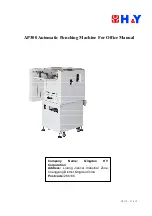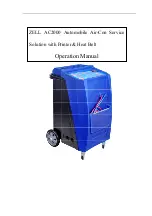
-
2
-
-
3
-
JBL SYNTHESIS SDEC-3500/SDEC-4500
JBL SYNTHESIS SDEC-3500/SDEC-4500
TABLE OF CONTENTS
Introduction, and Installation Considerations .................... 2
Controls and Indicators – Front Panel .............................. 3
Rear Panel Connections ................................................. 4
Input/Output Connections
SDEC-3500 ................................................................ 5
SDEC-4500 ................................................................ 6
SDEC-4500 With Bi-Amplified Front Speakers .......... 7
SDEC-4500 With Full-Range Front Speakers ............ 8
Techincal Specifications .................................................. 9
INTRODUCTION
Thank you for purchasing a JBL Synthesis SDEC Series Digital Equalizer. You now have at your
command a unique product that enables your Synthesis System to deliver the best possible
sonic performance regardless of the content being played and your room environment, whether
you are playing the latest blockbuster movie, a major sporting event or your favorite music.
This Installer's Manual gives you the information needed to connect your Digital Equalizer to the
other components in your home theater system as well as to describe its configuration, setup
and operation. Additional support information may also be found in the Support Section of
the JBL Synthesis web site at www.jblsynthesis.com. Of course, you may always contact JBL
Synthesis Customer Service at 888-691-4171.
Welcome to the Synthesis family, we wish you many years of listening pleasure!
FEATURES
• Up to 512 bands of fully parametric EQ
• Built-in crossover for bi-amp outputs (SDES-4500 only)
• Delay adjustement for each output
• Delay adjustment for driver compensation
• Screen compensation
• Driver compensation
• Web-based Java remote for basic system setup
• Windows application for advanced system setup
• Custom configuration possible
• Remote VPN monitoring
• Four subwoofer outputs
• Three pairs of side speaker outputs for large rooms with
multiple rows of seating (SDEC-4500 only)
• 24-Bit DSP
• 96kHz sample rate on all inputs and outputs
• Balanced or single-ended (unbalanced) inputs and outputs
INSTALLATION CONSIDERATIONS
To ensure optimal performance, please pay attention to the instructions in this Manual.
• Install your SDEC on a solid, flat, level surface that is dry, well-ventilated and out of
direct sunlight.
• Do not place your SDEC directly on a carpeted surface or cover any of the ventilation holes.
• Do not install your SDEC on a surface that is unstable or unable to support all four feet.
• Do not install it directly above another product, and do not put another product directly on
top of the SDEC.
• Do not expose the SDEC to high temperatures or humidity, steam, smoke or excessive
dampness or dust.
Front Panel Controls & Indicators
B
INPUT/OUTPUT CARD MONITORING:
Each channel has three LED indicators showing:
CLIP –
Indicates clipping in the analog domain for each channel of the fitted input or output
card. The LED will light at +18.5dB.
SIGNAL –
The signal LED will light for each channel of a fitted input or output card when the
signal reaches or exceeds the signal threshold of – 20dB.
SYNC/48V –
This feature is currently not supported by JBL Synthesis (lights to indicate that
+ 48V “phantom” power has been activated for the relevant channel of a fitted input card or
that Digital Sync is valid).
C
DATA ACTIVITY:
The data activity LED flashes when the SDEC is communicating with another
control device, either on the network or via the serial or control ports.
D
NETWORK LINK:
The network link LED indicates the presence of Ethernet cables. If no cables
are connected, the LED will be dark. The network link is used for configuring and calibrating the
Synthesis system when using the DACS calibration.
E
INFORMATION DISPLAY:
The information display indicates the name/ID and IP address of
the unit.
F
HOLD:
Press and hold this button to cycle the Information Display cycle the LCD through its
contrast range.
G
LOCATE:
Press this button to illuminate the Locate button on the rear panel.
FRONT PANEL CONTROLS & INDICATORS
B
C
D
E
F G
Introduction, and Installation Considerations

























